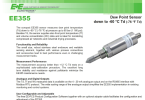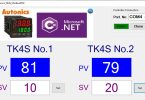1. What is Temperature Sensor?
Temperature sensor is a device used to sense the change of physical quantities without electrical properties (temperature, pressure, flow …) to be measured into quantities (usually electrical) can measured and processed.
Temperature is a physical quantity characteristic of the thermal state of matter which greatly affects many properties of objects and measuring temperature plays an important role in industrial production and many other fields.
Temperature sensor is a device used to sense the change in temperature of a quantity need to measure.
2. Temperature sensor classification
2.1 Thermocouple

- Structure: Consists of 2 different metal wires soldered with one end called a hot head (or measuring head), the other two are called cold (or standard). When there is a temperature difference between the hot and cold head, there will be an electric power V at the cold head. It is a question of stability and the temperature at the cold end, which depends very much on the material. Therefore, new types of thermocouples are available, each producing a different amount of electromotive force: E, J, K, R, S, T. You should note this to select the probe and controller for suitable.
- Working principle: Temperature changes give rise to variable electromotive force (mV).
- Advantages: Durable, high temperature measurement.
- Disadvantage: Many influence factors cause errors. The sensitivity is not high.
- Suitable for: Thermal furnaces, harsh environments, compressor oil viscosity measurements, …
- Measuring range: -100 >>> 1400 °C
2.2 RTD (Resitance Temperature Detector)

- Structure: The structure of RTD includes metal wires made from: Copper, Nikel, Platinum, … wrapped depending on the shape of the probe. When the temperature changes, the resistance between the two metal wires will change, and depending on the metal material will be linear in a certain temperature range. The most popular of the RTDs is the Pt sensor type, made from Platinum. Platinum has high resistivity, anti-oxidation, high sensitivity, long measured temperature range.
RTD usually has 2-wire, 3-wire and 4-wire types. - Working principle: When the temperature changes, the resistance between the two metal wires will change, and depending on the metal material will be linear in a certain temperature range.
- Advantages: More accurate than thermocouple, easier to use, unlimited wire length.
- Disadvantage: The measuring range is smaller than thermocouple, the price is higher than thermocouple.
- Suitable for: In general industries, environmental industries or processing of materials, chemicals, …
- Measuring range: -100 >>> 700 °C
2.3 Thermistor

- Structure: Thermistor is made up of a mixture of ocid powders. These powders are mixed in certain proportions and mass and then compacted and calcined at high temperatures. And the conductivity of this mixture will change as the temperature changes.
- Working principle: Change resistance when temperature changes.
- Advantages: Durable, cheap, easy to fabricate.
- Disadvantage: Narrow linear range.
- Suitable for: Doing protective functions, pressing on motor coils, electronic circuits.
- Measuring range: 50 °C
2.4 Semiconductor Thermal Sensor

- Structure: Semiconductor heat sensors are types of sensors made from semiconductors. There are types such as Diode, Transistor, IC. Their principle is based on the degree of polarization of linear P-N layers to ambient temperature.
- Working principle: The polarity of the semiconductor is affected by temperature.
- Advantages: Turn money, easy to manufacture, high sensitivity, good anti-jamming, simple processing circuit.
- Disadvantage: Not resistant to high temperatures, less durable.
- Suitable for: Measurement of air temperature, used in measuring devices, to protect electronic circuits.
- Measuring range: -50 >>> 150 °C
2.5 Pyrometer

- Structure: Pyrometer is a specialized device used to measure the temperature of the environment that conventional sensors cannot access (steel furnaces, strong corrosive chemicals, difficult to place sensors).
- Working principle: Measurement of energy radiation properties of a heat-carrying medium.
- Advantages: Use in harsh environments, without contact with the measuring environment.
- Disadvantage: Accuracy is not high, expensive
- Suitable for: Making equipment for a kiln.
- Measuring range: -54 >>> 1000 °C








